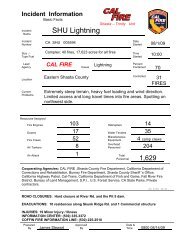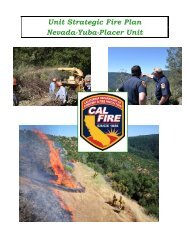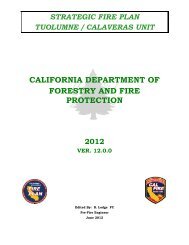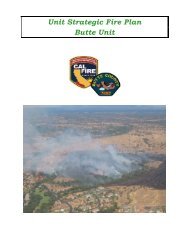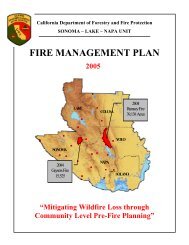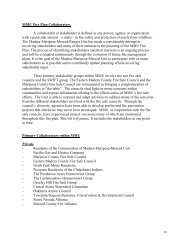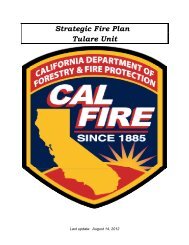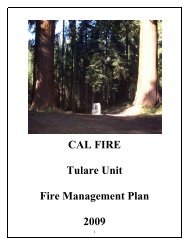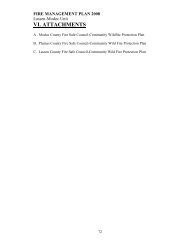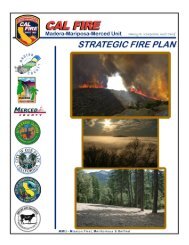Nevada-Yuba-Placer Strategic Fire Plan 2011 - Board of Forestry ...
Nevada-Yuba-Placer Strategic Fire Plan 2011 - Board of Forestry ...
Nevada-Yuba-Placer Strategic Fire Plan 2011 - Board of Forestry ...
You also want an ePaper? Increase the reach of your titles
YUMPU automatically turns print PDFs into web optimized ePapers that Google loves.
<strong>Placer</strong> County is the second fastest growing county in California with a population growth <strong>of</strong><br />
40.3 percent since 2000, second only to Riverside County which grew by 41.7%, a margin <strong>of</strong><br />
just under 1.5%. In 2010, the total population in <strong>Placer</strong> County was reported to be 348,432<br />
people, a 40.3% increase over the previous decade. The population was composed primarily <strong>of</strong><br />
permanent adult residents with 76% <strong>of</strong> the population over 18 years <strong>of</strong> age and a 74% home<br />
ownership rate. As <strong>of</strong> 2009, a total <strong>of</strong> 148,518 housing units were reported. With a land area <strong>of</strong><br />
898,787 acres, the population density averages 248 persons per square mile. Higher population<br />
densities correlate to the transportation corridors including Interstate 80, Highway 65, Highway<br />
49, Highway 193, Highway 174, and Highway 89 and on the eastside <strong>of</strong> the County. Population<br />
density also correlates to the State and Local Responsibility Areas within the County.<br />
Based on current economic forecasts, <strong>Placer</strong> County growth projections through 2020 are<br />
expected to be 23%. The 2010 census data shows an actual growth rate <strong>of</strong> 40.7% for the period<br />
2000 to 2010. Assuming the range <strong>of</strong> potential growth through 2020, using the current average<br />
rate (40.3%) and the projected rate (23%) from <strong>Placer</strong> County sources, the 2020 population in<br />
<strong>Placer</strong> County will range from 437,000 to 517,000 people. Growth policies within <strong>Placer</strong> County<br />
are geared toward development while preserving open space for maintenance <strong>of</strong> resource<br />
values. Current proposals include instituting the <strong>Placer</strong> County Conservation <strong>Plan</strong> (PCCP), a<br />
plan that is intended to place 50,000 acres <strong>of</strong> developable lands in the foothill areas <strong>of</strong> the<br />
County into permanent conservation to ensure the preservation <strong>of</strong> agriculture, open space and<br />
wildlife habitat. As development continues into the future, added pressure will be placed on the<br />
upper elevations <strong>of</strong> <strong>Placer</strong> County to <strong>of</strong>fset the acres removed from development through<br />
implementation <strong>of</strong> the PCCP. Zoning restrictions on forested lands in <strong>Placer</strong> County generally<br />
restrict development to parcel sizes from 2.3 acres to 80 acres, leaving a large wildland<br />
component despite the development. Current conditions in the County are indicative <strong>of</strong><br />
development in the wildland where larger parcels and open space retention have created a true<br />
WUI condition. These practices are expected to continue into the future.<br />
Sierra County<br />
Sierra County is a truly rural County. In 2010, the total population in Sierra County was reported<br />
to be 3,240 people, an 8.9% decrease over the previous decade. The population was composed<br />
primarily <strong>of</strong> permanent adult residents with 82% <strong>of</strong> the population over 18 years <strong>of</strong> age and a<br />
74% home ownership rate. As <strong>of</strong> 2009, a total <strong>of</strong> 2,295 housing units were reported. With a land<br />
area <strong>of</strong> 610,163 acres, the population density averages less than 4 persons per square mile.<br />
Population densities correlate nearly exclusively to the transportation corridors including<br />
Highway 49, and 89 and also the vast Sierra Valley which has long been a population and<br />
economic center with deep roots in agriculture. Population density also correlates to Local<br />
Responsibility Areas within the County. SRA acres are exclusively interspersed among Federal<br />
lands and are Federal DPA with some LRA around Downieville and in the Sierra Valley.<br />
Based on current economic forecasts, Sierra County growth projections through 2020 are<br />
expected to decrease by up to -1%. The 2010 census data shows an actual population shrink<br />
rate <strong>of</strong> 8.9% for the period 2000 to 2010. Assuming the range <strong>of</strong> potential growth through 2020,<br />
using the current average rate (-8.9 %) and the projected rate (-1%) from State sources, the<br />
2020 population in Sierra County will range from 2,952 to 3,208 people. Based on this decrease<br />
in growth and the current state <strong>of</strong> responsibility for fire protection, Sierra County is not expected<br />
to be a significant influence on NEU <strong>Fire</strong> <strong>Plan</strong>ning, however, citizens within the County have<br />
expressed an interest in assistance to develop and implement a CWPP for the County. NEU will<br />
continue to provide guidance and support to fulfill this need.<br />
Sutter County<br />
Sutter County is a strong agricultural community and is very rural. In 2010, the total population<br />
in Sutter County was reported to be 94,737 people, a 20% increase over the previous decade.<br />
- 10 –



